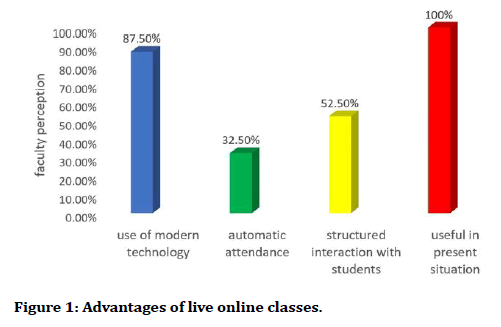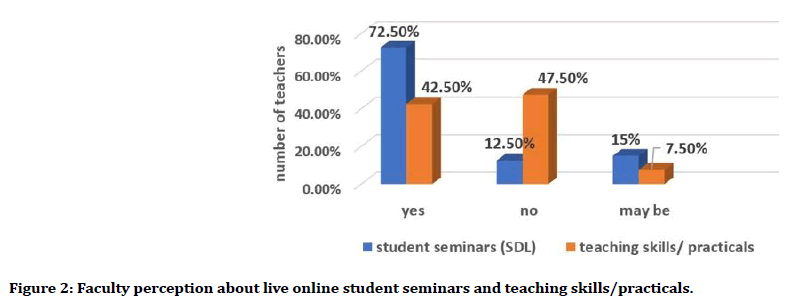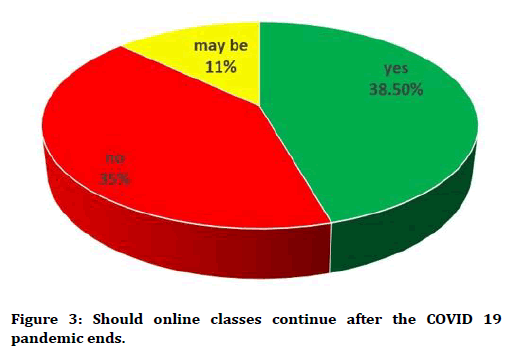Research - (2020) Volume 8, Issue 4
Online Classes for Medical Students During COVID-19 Pandemic: Through the Eyes of the Teaching Faculty
*Correspondence: Shruti Bhargava, SMS Medical College, India, Email:
Abstract
Background: Today, the widespread COVID 19 pandemics has threatened medical education of undergraduate students unprecedently. During the lockdown, with the principles of social distancing, all the classroom teaching for these students had to be suspended, all over the world. Thus, at one point of time, all undergraduate teaching learning had come to a standstill. This study was conducted to gather the perception of teaching faculty about the live online classes during the COVID 19 pandemic.
Methods: We started regular live tele teaching through video conference platform, Cisco WebEx software, in our institute where two classes were held daily for each of the four batches of MBBS. The perception of all the forty faculty, who took these online classes was collected at the end of two months of such teaching.
Results: The faculty perceived the online classes on a positive note, during the present pandemic situation, within limitations. But they also felt that such classes cannot replace the classroom teaching after the present emergency gets over.
Conclusions: This study about the perception of faculty for these live online classes for medical undergraduate students concluded that this endeavor is a welcome stop gap arrangement in the time of COVID pandemic, so that the learning continues.
To the best of our knowledge, ours is the first study of its kind, dealing with the innovation done to deal with undergraduate medical education during the COVID 19 pandemic.
Keywords
COVID 19, Tele teaching video conference, Online classes, Undergraduate medical students, Medical education, Faculty
Background and Objectives
With the emergence of COVID 19 pandemic, there was a shift in the role of medical teachers entirely towards care of patients and community instead of teaching the medical students also [1]. The most effective preventive strategy for COVID 19, the Social distancing, disallows students from gathering in lecture halls or small group rooms [2,3]. Hence all medical colleges across the country suspended all classroom teachings to avoid further spread of the pandemic. But, even in this uncertain environment, it was important that the learning continued, even if it was not possible face to face.
So, the COVID 19 pandemic brought a huge change in medical education as it shifts the focus from the traditional in-house lectures and bed side teachings to the technology driven online classes. Over the past few years some colleges have been using the online or electronic learning more frequently as compared to traditional forms of “in person ’ lecture-based teaching as an add on to the traditional form of class room lecture based learning [4]. Still, in almost all medical schools of the country, students used to convene in physical settings [3]. Although not ideal, but live online classes through video conferencing seem to be an apt solution for continuing the teaching of undergraduates in medicine, while observing appropriate COVID 19 social distancing measures [1].
Although a lot of information is available to students on the internet for learning, but live online teaching by teachers guides the student learning in proper context of their curriculum. Keeping this in mind, a regular schedule of live teleteaching was planned and live online lectures were delivered through video conferencing to all 1000 students of MBBS at one of the largest government medical college of India. This study was conducted to find out the faculty’s perception about these live online classes after conducting them for two months during the lockdown.
Materials and Methods
This study was done at one of the largest medical college of India and presently has around 1000 undergraduate students on roll, being divided into four years of MBBS. This venture to conduct live online lectures through video conferencing for all the four batches of MBBS was started to cater to the undergraduate teaching during lockdown due to COVID 19 Pandemic.
The timetable for all four batches was planned and everyday each batch was subjected to two live lectures across their subjects of study. The institute faculty were sensitized for using the software and online teaching modus operandi prior to launch of these classes. It involved training of faculty about how to use the software followed by conduction of two trial classes for the teaching faculty itself. Once the faculty was trained, two video conferencing relay stations were set up in a designated area and live online classes were taken by these faculty for all four years of MBBS.
This was monitored centrally and carried out using the Cisco WebEx software, which was provided by the Government of Rajasthan to the institute. This software allowed the students to join the meeting using a login id and password and then the teachers took lectures by explaining their topics via power point presentations and online white board during the video conferencing. The students were able to ask questions and clear doubts during and at the end of each class. Then the students were given a test at the end of the topic by sending multiple choice questions and asking them to submit it via google form. Over a period of two months, forty medical teachers from various sub-specialties across undergraduate curriculum, had taken these classes. The perception of all these forty medical teachers was taken after two months of continuing this endeavor.
This was the first learning experience for both the teachers and students where a systematically scheduled, centrally controlled live online teaching was done at one of the largest government sector medical college in the country, although previously faculty used to attend webinars online. All precautions pertaining to the COVID 19 pandemic were ensured, while carrying out these classes.
Results
Feedback responses were obtained from the faculty after the conduction of these classes for a period of two months. All the forty medical teachers, who had taken these live online classes participated in the study.
Most of the teachers [n=18 (45%)] had conducted five to ten classes in the past two months.15 teachers (37.5%) took less than five and 7 teachers (17.5%) more than ten classes in the entire study duration.
Almost all teachers [n =38 (95%)] were comfortable in taking these online classes and were able to cover their respective topic in stipulated timeframe.
Majority of the faculty listed the use of modern technology as the prime advantage of these classes (Figure 1). The other benefits observed by the faculty were automatic attendance and structured interaction with the students without any disturbance. All the 40 participating faculty accepted that such classes were useful during the COVID 19 pandemic as a means to continue the learning.

Figure 1. Advantages of live online classes.
72.5% of the faculty was of the strong opinion that student seminars should be conducted via live videoconferencing platform during these classes, to promote self-directed learning, while 12.5% faculty were not sure and only 15% faculty did not like the idea (Figure 2). However, at the same time 47.5% of the faculty was not incredibly positive towards teaching skills or practical work through these classes, as they felt a face to face interaction is must for this section of the curriculum (Figure 2). The limitations of these classes, that the faculty experienced were limited interaction with the students as compared to a real classroom, monotony of delivering their lecture in a closed room and occasional technical issue of slow internet connection. There was a mixed response to the question of continuing these types of classes after the pandemic got over. (Figure 3).

Figure 2. Faculty perception about live online student seminars and teaching skills/practicals.

Figure 3. Should online classes continue after the COVID 19 pandemic ends.
In the open comments, participants responded that these online classes were a welcome change in times of COVID pandemic and lockdown. The faculty was appreciative of the fact that the academic administration was trying its level best to provide quality education to students, along with catering to the immense workload of managing COVID patients, as one of the largest teaching institute of the country, in government sector.
However, mostly the faculty felt that teleteaching cannot totally replace the actual classroom contact and even the patient- student contact in clinical teaching. Developing the interpersonal skills and clinical acumen was a difficult task through this type of teaching learning. The questionable attention of students due to structured interaction as well as the monotony of conducting the class were other factors responsible for this point of view of the faculty.
Discussion
The COVID -19 made us realize the importance of online classes as a substitute of the regular classrooms, in times of calamity. In the absence of this venture, majority of med colleges had stopped the classes totally in this time. Medical teachers, as doctors, are already the frontline corona warriors in the community’s fight against this pandemic. Also, there is uncertainty regarding how long this situation will persist. So, it was a challenge for our institute to adapt everyone to new mode of teaching our students, who happen to be future doctors. These classes are being organized centrally at our institute, with a proper organized schedule and not at the disposal of faculty per se. This ensures quality assurance of internet connectivity, audio visual quality and time management. This also maintains a decorum of academic timetable for the students as well as faculty. In most other institutions of medical and nonmedical disciplines, these are being organized at disposal of individual teachers and students instead of a centralized effort which increases the challenges faced for smooth execution and quality assurance.
While the initial shift online was difficult for both the administration as well as the faculty, ultimately it was perceived as a welcome move to combat the substantial loss of learning time of our students. Although these tele teaching endeavors can be a stop gap arrangement in these emergency times, but they cannot overpower the classroom teaching due to the inherent limitations of lack of personal touch, presently available technology.
Literature search did not reveal any studies pertaining to perception of medical faculty about systematic live online learning during the COVID pandemic. However, Arora et al in their study on perception of teachers from higher education centers, also pointed out similar drawbacks of the online teaching process [4]. Despite these drawbacks, they advocate these online classes to be a promising tool to continue the learning process in the times of calamity. The well-tailored, systematically executed venture of live online classes can also in future be used for innovating some form of assessment for the students. But in such classes the importance of maintaining a student-centered approach with doubt clearing sessions, creative conceptualization and interdepartmental coordination cannot be undermined [5,6].
It is wonderful that technology has enabled millions of students to keep learning even when direct contact is impossible. However, a physical classroom environment and interaction has been perceived as the best form of teaching-learning method. So, we can say that the online learning hasn’t threatened the traditional model of inperson learning. We conclude that these live online classes conducted as tele teaching video conference were an easy, feasible and cheap alternative to the classroom teaching of undergraduates during this time of COVID 19 pandemic. They can also be used sometimes in future as an adjunct to offline classes, for the benefit of the students. But they cannot totally replace the traditional classroom teaching due to the lack of interaction and personal touch, which is an especially important component of medical education.
No one knows, till when these unprecedented times will last. Our venture of live online classes may act as a small contribution towards continuing the training of the medical undergraduate students, who are the future doctors. Our attempt has been well appreciated by our teachers, within limitations, and we hope that this experience will help us in preparing for such paralyzing times in future.
Ethical Considerations
Exempt review.
Conflict of Interest
Nil.
Funding/Support
Nil.
References
- Mian A, Khan S. Medical education during pandemics: A UK perspective. BMC Medicine (2020)18: 100.
- Ferrel MN, Ryan JJ. The Impact of COVID-19 on medical education. Cureus 2020; 12:e7492.
- Rose S. Medical student education in the time of COVID-19. JAMA 2020; 323:2131-2312.
- Arora AK, Srinivasan R. Impact of pandemic COVID-19 on the teaching, learning process: A study of higher education teachers. Indian J Management 2020; 13.
- O’Doherty D, Dromey M, Lougheed J, et al. Barriers and solutions to online learning in medical education: An integrative review. BMC Med Educ 2018; 18:130.
- Chatterjee S. The COVID-19 pandemic through the lens of a medical student in India. Int J Med Students 2020; 8:82-83.
